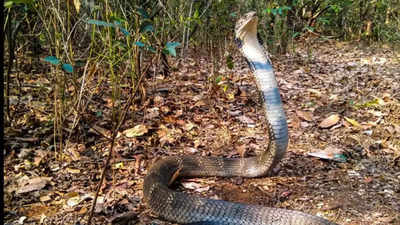Trending
King cobra: The world’s longest venomous snake now classified into four species; know more about newly discovered species
The king cobra, previously considered one species, has been reclassified into four distinct species based on extensive genetic analysis spanning nearly 20 years. This reclassification is pivotal for conservation and improving medical treatments for snakebites, as it allows targeted protection and region-specific antivenoms. Newly identified species include the Northern, Sunda, Western Ghats, and Luzon king cobras.
The world's longest venomous snake, called the king cobra, is actually divided into four species now due to reclassifications according to recent findings. This classification change was conducted as a culmination of extensive study over nearly 20 years undertaken by P. Gowri Shankar regarding these particular snakes. Following an earlier publication from 2021, identifying four distinct genetic groups of the king cobra, the scientists had built their study on top of that paper. Scientists have formally identified two of these groups through detailed genetic analysis as being completely new species.
The reclassification of the king cobra into four species represents a significant step forward in the knowledge of these incredible reptiles. This classification is of utmost importance in the conservation of their population, as each species would consequently receive the protection it deserves. Furthermore, through this new classification, medical responses to snakebites would improve through greater treatment options, thus conserving human and king cobra populations alike. Further studies on the species will thus enhance the comprehension of their habits, habitats, and venom by scientists, bringing in more direct actions to their protection and habitats.
Four king cobra species discovered
For 188 years, the king cobra has been recognized as a single species, Ophiophagus hannah. However, this species, found across a wide range, exhibits significant variations in body coloration and other physical traits in different regions, prompting scientists to reconsider whether it truly constitutes a single species.
King cobra's genetic and behavioral diversity leads to new species classification
Originally, the king cobra was known to science under the name Ophiophagus hannah, which it received from Danish zoologist Theodore Edward Cantor in 1836. This genus name is a Greek compound of "ophis" (snake) and "phagein" (to eat), which describes the king cobra as a snake that consumes other snakes. These facts convinced the scientific community that populations of king cobras throughout their range showed significant genetic differences, with important morphological and behavioral diversity. Thus, the recent reclassification of the species occurred.
Need for reclassification and its implications
This reclassification is important for understanding the diversity of king cobras, and it is essential for conservation and medical treatment. The newly described species emphasise the specific environmental requirements of each population, especially the vulnerable ones with limited habitats and ongoing threats from habitat destruction, hunting, and human-wildlife conflict. For example, the Western Ghats King Cobra is only found in the Indian Western Ghats, and due to habitat loss, it faces a high threat of extinction; Luzon King Cobra is a species that occurs only on the Luzon Island, Philippines, where it is at risk of habitat loss. By recognising these snakes as separate species, conservation efforts can be more specifically tailored to each population, ensuring more effective protection.
The reclassification directly impacts conservation efforts to be put in place for the protection of the king cobra. Every species has unique habitat requirements and faces different threats, and each requires a unique approach to the issue. For instance, the Western Ghats King Cobra requires the preservation of its rainforest habitat in India, whereas the Sunda King Cobra is under threat from Southeast Asia's fast-developing landscapes. Targeted conservation efforts for these species will mitigate the risks that they face and promote their long-term survival.
Implications for snakebite treatment
Beyond conservation, the reclassification has significant implications for medical research, especially in the treatment of snakebites. King cobra venom is neurotoxic and has different effects depending on the region. Venoms from different populations of king cobras might have a slightly different chemical composition. Once these genetic and regional differences are recognized, it will be possible to create more region-specific antivenoms, thus improving the chances of effective treatment for snakebite victims. It is possible for saving lives, particularly in countries with significant infestation areas in Southeast Asia and parts of India, where people could benefit if there are available antivenoms specific to the venoms of those unique species of cobras.
Behavioral Diversity:
Also Read | GPS-tagged white-rumped vulture travels 4,000 km from Tadoba to Tamil Nadu
End of Article
FOLLOW US ON SOCIAL MEDIA
Visual Stories
Tired of too many ads?go ad free now










